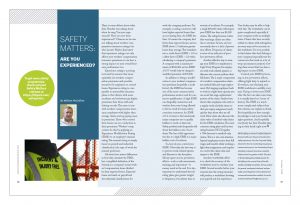Safety Matters: Are You Experienced?
There is some debate about what Jimi Hendrix was asking about when he sang “Are you experienced? Have you ever been experienced?” Chances are he was not talking about workers’ compensation insurance ratings, but who knows? Maybe Jimi knew that experience ratings not only affects your workers’ compensation insurance premiums, it can have a strong impact on your overall business performance too.

Experience rating is a pricing tool used by insurers that more equitably sets workers compensation premiums and provides incentive for employers to control losses. Experience rating is comparable to automobile insurance plans in that drivers with more accidents and violations pay higher premiums than those with safe driving records. The same is true with workers’ compensation insurance; employers with higher than average claims end up paying more in premiums. Those who control their losses can see a reduction in their premiums. Workers’ comp carriers do this by applying an Experience Modification Rating (EMR) to an employer’s manual rating. The manual rating is simply based on payroll and industrial classification (the type of work the insured performs).
All states have minor differences in how they calculate the EMR, but a simplified definition of the formula is a company’s actual workers’ compensation losses divided by their expected losses. Expected losses are based on payroll and the industrial classifications for work the company performs. For example, a roofing contractor will have higher expected losses than an accounting firm. An EMR less than 1.0 means the company had fewer than expected losses, and an EMR above 1.0 indicates greater losses than average. This translates into a credit factor (EMR < 1.0) or a debit factor (EMR > 1.0) when calculating a company’s premium. A company with a manual premium of $100,000 and an EMR of 0.75 would only be charged a modified premium of $75,000.
In addition to being a modification to your workers’ compensation premium (hopefully a credit factor); the EMR has become one of the most common safety performance metrics used for contractor qualification. A high EMR can disqualify contractors and vendors from even being allowed to bid on work for many safety-conscious customers. An EMR of 1.0 or lower is the benchmark many companies use to qualify bidders to work on their site. Safety professionals frequently talk about the hidden costs of accidents. The loss of bid opportunities due to a high EMR is a major hidden cost of accidents.
So, how do you control your EMR? Obviously, the best way is to prevent work-related injuries and illnesses in the first place. Money spent on loss prevention efforts—such as risk assessments, training, and inspections—is money saved in the end. It is also important to understand that all rating plans give greater weight to frequency of accidents than to severity of accidents. For example, a single $50,000 claim will impact your EMR less than ten $5,000 claims. The rating bureaus realize that very large claims are often due to extrinsic factors, and not necessarily due to a lack of prevention efforts. Frequency of claims is more of an indicator of poor loss-prevention efforts.
Another effective way to manage your EMR is to implement a Light Duty Program for employees with work-related injuries or illnesses who cannot perform their full duties. The 2 major components of a worker’s compensation claim are medical bills and wage replacement. By bringing employees back to work in a light duty capacity you can avoid the wage-replacement portion of the claim. Studies have shown that employees who stick to a regular work schedule return to their pre-injury assignment much quicker than those who are off work. Most states also discount the claim value of medical-only claims for the EMR calculation. The most common rating plan used by state rating bureaus (NCCI) applies a 70% discount to medical-only claims. This is a win-win situation. Injured employees receive their full wages and benefits while working a light duty assignment, and employers control the claim value and impact to the EMR.
Another worthwhile effort is to check the accuracy of the worksheets used to calculate your EMR. Several months before your renewal date the rating bureau(s) will produce a worksheet showing your payroll and loss experience. Your broker may be able to help with this. The worksheets can be quite complicated, especially if your company works in multiple states. Claims that have recently settled or claims with subrogation recovery may not be accurate on the worksheet. It’s even possible to find claims that don’t belong to your company (especially true for contractors that work on a lot of wrap up insurance projects). Getting these errors fixed can have a big impact on your EMR.
Control your EMR by focusing on loss prevention efforts, offering light duty to injured or ill workers, and checking your EMR worksheets carefully every year. Trying to lower your EMR after the fact can take some time; it is usually based on 3 years of history. The EMR is a much more complicated subject than this column can explain in detail. But hopefully you have enough knowledge to ask your broker the right questions. And hopefully everybody has Jimi Hendrix playing in their heads right now.
Copyright Statement
This article was published in the October 2018 issue of Insulation Outlook magazine. Copyright © 2018 National Insulation Association. All rights reserved. The contents of this website and Insulation Outlook magazine may not be reproduced in any means, in whole or in part, without the prior written permission of the publisher and NIA. Any unauthorized duplication is strictly prohibited and would violate NIA’s copyright and may violate other copyright agreements that NIA has with authors and partners. Contact publisher@insulation.org to reprint or reproduce this content.
